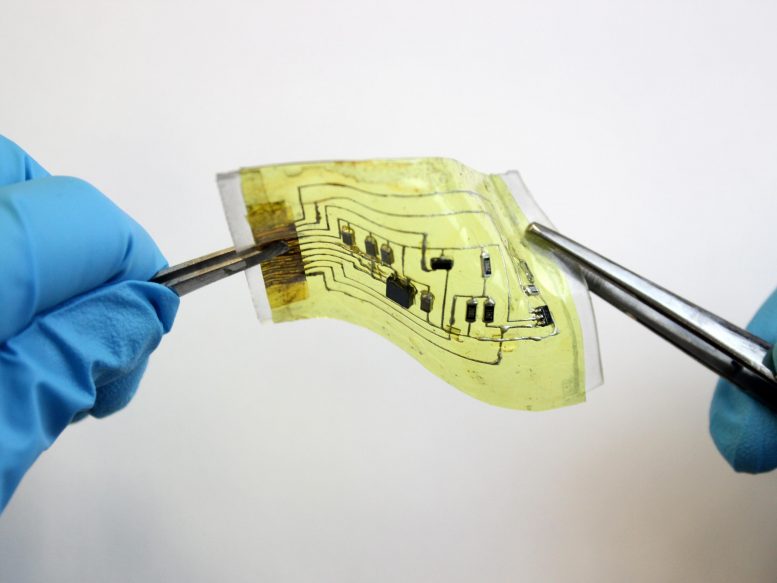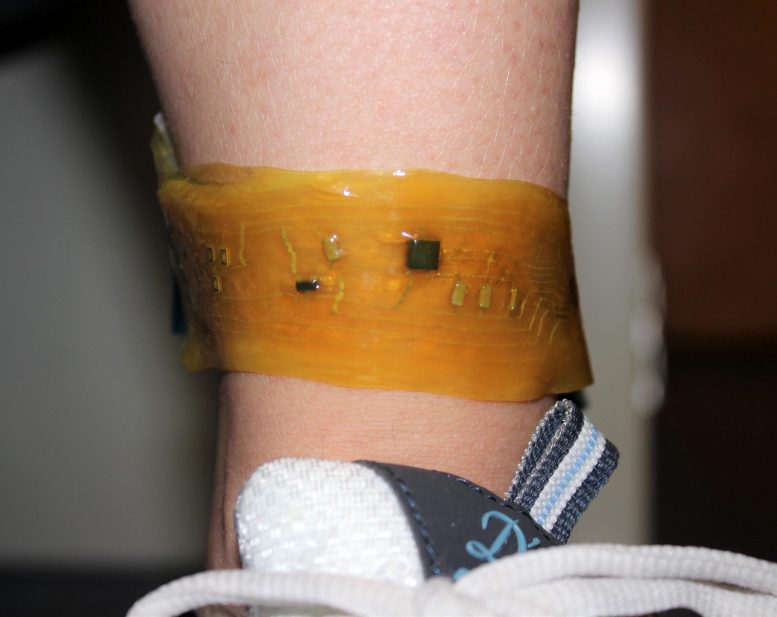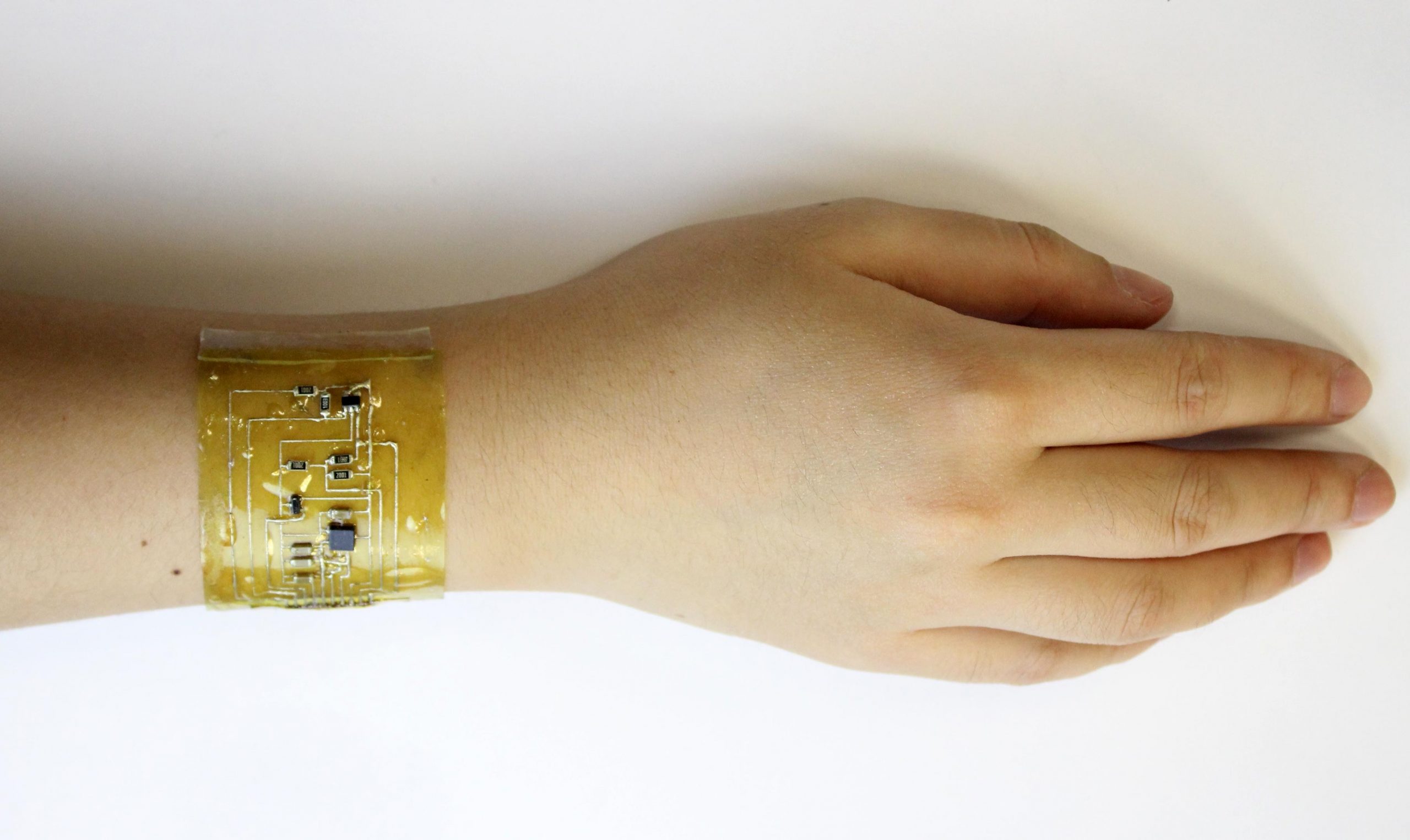A person wears an “electronic skin device” on their wrist. Photo credit: Chuanqian Shi
Researchers at the University of Colorado Boulder are developing a portable electronic device that is “truly portable” – a stretchable and fully recyclable circuit board that is inspired and adhered to human skin.
The team, led by Jianliang Xiao and Wei Zhang, describes its new “electronic skin” in an article published today in Science Advances. The device can heal itself, much like real skin. It also reliably performs a range of sensory tasks, from measuring users’ body temperature to keeping track of their daily step counts.
And it’s reconfigurable, which means the device can be shaped to fit anywhere on your body.
“If you want to wear this watch like a watch, you can wrap it around your wrist,” said Xiao, an associate professor in the Paul M. Rady Department of Mechanical Engineering at Boulder CU. “If you want to wear this like a necklace, you can put it on your neck.”

A new “electronic skin” device can stretch 60% in any direction without losing functionality. Photo credit: Chuanqian Shi
He and his colleagues hope their creation will help redefine the possibilities of wearable devices. The group said that one day such high-tech skin could enable people to gather accurate data about their bodies – while reducing the world’s growing amounts of electronic waste.
“Smart watches are functionally good, but they’re always a big piece of metal in a band,” said Zhang, a professor in the Department of Chemistry. “If we want a truly portable device, ideally it is a thin film that fits comfortably on your body.”
Stretch out
These thin, comfy films have long been a staple of science fiction. Imagine the Arnold Schwarzenegger skin peeling off in the Terminator film franchise. “Our research is in this direction, but we still have a long way to go,” said Zhang.
However, his team’s goals are both robots and humans. The researchers described their design for electronic skin back in 2018. However, the latest version of the technology improves the concept considerably – first of all, it is far more elastic and, last but not least, functional.

A user wears an “electronic skin device” on their ankle. Photo credit: Chuanqian Shi
To make their bouncy product, Xiao and his colleagues use screen printing to create a network of liquid metal wires. These circuits are then sandwiched between two thin films made of a highly flexible and self-healing material called polyimine.
The resulting device is slightly thicker than a band-aid and can be applied to the skin with heat. It can also stretch 60% in any direction without disrupting the electronics inside, the team reports.
“It’s really stretchy, which allows for a lot of options that weren’t an option before,” said Xiao.
The team’s electronic skin can do many of the same tasks as popular wearable fitness devices like Fitbits: reliably measuring temporary bodies, heart rate, movement patterns, and more.
Less garbage
Arnold might want to note: The team’s artificial epidermis is also remarkably resilient.
When you slice a piece of electronic skin, all you have to do is squeeze the broken parts, Zhang said. Within a few minutes, the bonds holding the polyimine material together begin to reform. The damage is almost undetectable within 13 minutes.
“These bonds help create a network across the intersection. Then they grow together, ”said Zhang. “It’s similar to skin healing, but we’re talking about covalent chemical bonds.”
Xiao added that the project also represents a new approach to making electronics – one that could be much better for the planet. It is estimated that more than 55 million tons of discarded smartphones, laptops and other electronic devices will be produced by 2021.
However, his team’s stretchy devices are designed to skip the landfills. If you soak one of these patches in a recycling solution, the polyimine will depolymerize or separate into its molecular components as the electronic components sink to the bottom. Both the electronics and the stretchable material can then be reused.
“Our solution for electronic waste is to start with how we make the device, not from the endpoint or when it has already been thrown away,” said Xiao. “We want a device that is easy to recycle.”
The electronic skin of the team is far from being able to keep up with reality. Currently, these devices still need to be plugged into an external power source in order to function. However, according to Xiao, his group’s research suggests that cyborg skin may soon be the fad of the future.
“We haven’t done all of these complex functions yet,” he said. “But we are marching towards this device function.”
Reference: “Heterogeneous integration of rigid, soft and liquid materials for self-healing, recyclable and reconfigurable wearable electronics” by Chuanqian Shi, Zhanan Zou, Zepeng Lei, Pengcheng Zhu, Wei Zhang and Jianliang Xiao, November 6, 2020, Advances in science.
DOI: 10.1126 / sciadv.abd0202
Other CU Boulder co-authors on the new study are Chuanqian Shi, former visiting scholar; Zhanan Zou, former PhD student; Zepeng Lei, PhD student; and Pengcheng Zhu, visiting scholar.



